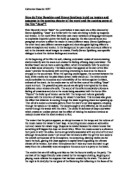Comment on the effectiveness of this extract from British playwright Peter Shaffer's Equus (1973), as the opening of a play. You may wish to consider stage directions, lighting, characterization and the use of suspense.
Comment on the effectiveness of this extract from British playwright Peter Shaffer’s Equus (1973), as the opening of a play. You may wish to consider stage directions, lighting, characterization and the use of suspense.
Peter Shaffer’s Equus has a critically significant opening that helps to shape the underlying themes and atmosphere of the play. The extract makes use of the elaborate stage directions and effects to create an atmosphere of suspense, thus enabling the opening to be effective in capturing the audiences’ attention.
Elaborate stage directions before the opening of the play tells us that the scene is to be set in total darkness and silence. These two aspects are usually associated with suspense and mystery, enabling the audience to be satisfactorily interested. The opening scene is already enshrouded in a peculiar aura and the next stage direction calling for dim light to be slowly lit up on the square further increases tension and anticipation as we wonder the next move. The viewers are introduced to the first character, Alan Strang. Directions specify his age and dressing and give guidance to directors who wish to stage “Equus” to provide a more compelling and exciting account of the play. We also see that Alan is fondling a horse called Nugget, along with the title “Equus” which translated, means horse, that the basic structure of the play will be linked to the subject of horses. The audience will also be able to make their first presumptions on the link between horses and Alan Strang. Elsewhere on the stage, directions are given “the flame of a cigarette lighter jumps in the dark”. The audience is kept expectant as to what will follow with such an entrance by Martin Dysart, marked only by the sudden spark of a cigarette lighter. They are also able to guess the connection between Dysart and Strang. These intricate stage directions for the directors who wish to stage “Equus” are effective in capturing audience attention before the play even commences properly, thus is successful as an aspect of the opening of the play. The lighting also helps to increase anticipation and suspense. As seen further down the opening, the change of lighting to a warmer sort marks the change of setting to a month back in Dysart’s recollections. Thus, lighting not only serves as an effective aspect of suspense, but also to help differentiate settings and time periods in the play. The audience is therefore treated to a clean switch between the present and the past a few times, with Dysart reminiscing and his thoughts being acted out and his monologue in between.







